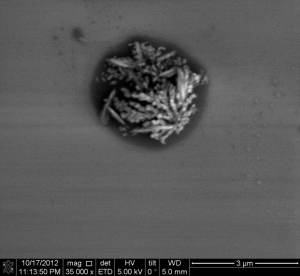Associate Professor Daniel Knopf has been named by the Environmental Molecular Sciences Laboratory (EMSL) at Pacific Northwest National Laboratory (PNNL) a Wiley Research Fellow in recognition of his important contributions to EMSL as a national scientific user and a proven record of generating highly impactful science.
EMSL is a national scientific user facility that provides integrated experimental and computational resources for discovery and technological innovation in the environmental molecular sciences to support the needs of DOE and the nation. Specifically, EMSL provides innovative solutions to the nation’s environmental and energy production challenges in areas such as atmospheric aerosols, feedstocks, global carbon cycling, biogeochemistry, subsurface science, and energy materials.
Daniel received this honor “for his demonstrated leader
ship in guiding investments and applications relating to the ice nucleation potential of authentic inorganic, organic and biogenic particles with their chemical and morphological features as determined by micro-spectroscopic analysis available at EMSL”. Using the facilities at EMSL Daniel’s group and his collaborators were able to show that anthropogenic organic particles can affect atmospheric ice crystal formation and thus cloud formation with subsequent effects on climate and the hydrological cycle. See e.g. Knopf at al., Geophys. Res. Lett., 37, L11803, doi:10.1029/2010GL043362 and Wang et al., J. Geophys. Res., 117, D00V19, doi:10.1029/2012JD017446.
An example of Daniel’s group research is seen in this image. This Scanning Electron Micrograph (SEM) shows an aged sea salt particle sampled in the Sacramento area, California. Dendritic structures are clearly visible engulfed by organic material shown as dark shadow. The organic material is likely secondary in nature (i.e. deu to condensation of oxidized volatile organic compounds) or primary stemming from marine biogenic material (such as fatty acids) and is dominated by COOH functionalities. The particle is heavily depleted in Cl due to the reaction of NaCl with these weak acids leading to the displacement of Cl by formation of gaseous HCl. This particle formed an ice crystal at -50 °C via depositional growth from the supersaturated gas phase, i.e. without the occurrence of liquid water.
Wiley Research Fellows contribute to the success of EMSL as a user facility by supporting the user program beyond their own specific research projects. Examples of these contributions include participation on EMSL advisory committees and partner proposals for development of new capabilities, acting as a scientific consultant for users, advocacy for EMSL and its capabilities in the scientific community, and assistance and support of a broad range of EMSL user activities.
EMSL’s research fellow program is named after William R. Wiley. The former director of PNNL, Wiley first conceived the idea of a Department of Energy Office of Science molecular sciences user facility and whose advocacy led to its creation.






You must be logged in to post a comment.